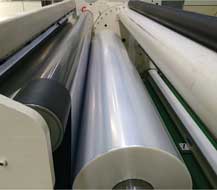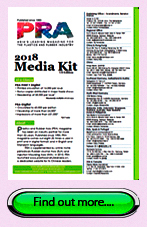PRA Chinese
Rubber Journal Asia Injection Moulding Asia Energy, Oil & Gas Asia
VISIT OUR OTHER SITES:
PRA Chinese
Rubber Journal Asia
Injection Moulding Asia
Energy, Oil & Gas Asia
New ironing roll winder modernises high-speed winding of large master rolls

US extrusion machinery maker Davis-Standard has introduced a new ironing roll winder that supports markets for larger diameter master rolls up to 1.2 m in diameter on cast film lines up to 6 m wide. This technology can be used for many film types, but Davis-Standard has found it to be most beneficial for CPP and barrier films where post wrap shrinkage occurs as a result of the types of polymers used in the film structures, or where blocking can occur due to a soft sealant layer with a high coefficient of friction (COF).
The winder incorporates programmable tension control, pre-spreading onto the winding roll, and servo-controlled web entry of the film to influence levelling or lay-flat of the film prior to the lay-on roll. Roll hardness is improved with a more precise loading force of the lay-on roll against the winding roll, controlling the in-wound air at higher production speeds than previously possible. When optimised these features can reduce defects such as tin-canning, caused by blocking and entrapped air, and resulting in annular raised bands on the roll face. Other defects such as buckling, telescoping, and starring can also be reduced with the control features and dynamics of the new winding system.
“The ironing roll winder offers a solution to a common problem while also improving product quality and profitability,” said Danis Roy, Davis-Standard’s Vice President of Sales, Cast Film and Coating Systems. “Current markets dictate processing of these films at slower production speeds and to limited diameters in order to produce defect-free wound rolls. We have experienced excellent results with this new winder in the field.”
Larger diameter master rolls significantly improve subsequent processing efficiency. A relatively small increase in diameter can significantly increase the film length on a roll. This reduces downtime in slitter re-winding as well as batch process like vacuum metallisation. The downside of winding larger roll diameters is the increased risk of in-wound defects.
The variable geometry of the ironing roll enables processors to pre-wrap the film onto the winding roll prior to the lay-on roll, allowing entrapped air to reduce the COF between each wrap. This promotes film flatness prior to engaging roll hardness with the lay-on roll. This results in improved control, preventing in-wound imperfections. The winder is available with a tapeless static knife or patented stationary knife automatic transfer systems, and shafted or shaftless operation to further support efficiency. Although the winder is primarily designed for large master roll winding, in-line slitting is also possible in some shafted applications.
(PRA)Copyright (c) 2017 www.plasticsandrubberasia.com. All rights reserved.

























































